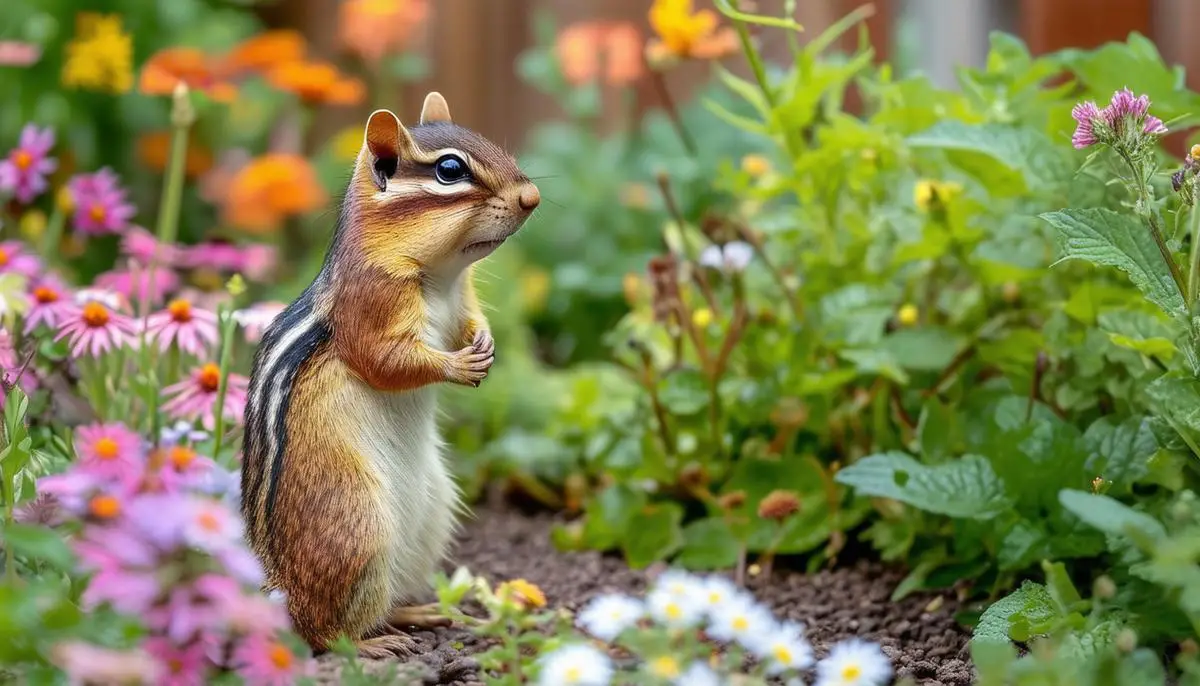Keep Chipmunks Away: 🐿️ Proven Defense Strategy & Natural Remedies for a Chipmunk-Free Home!

Physical Barriers for Chipmunks
Gravel, mesh, and L-shaped footers offer effective solutions to deter chipmunks from gardens and home foundations.
These techniques serve as direct barriers, preventing chipmunks from easily digging and creating homes in unwanted areas.
Utilizing Gravel as a Chipmunk Deterrent
Gravel can be used as a simple chipmunk barrier. Filling entrance holes to established tunnels and potential burrowing sites with fine-grained gravel disrupts chipmunks’ ability to dig and create homes near plant beds or under structures.
Use substantial amounts, firmly packing gravel into entry spots to reduce direct digging access for chipmunks.
Implementing Mesh Barrier Systems
Welded wire mesh or hardware cloth with small gap sizes can be used to block off subterranean tunnel access.
Line the soil around garden beds and the foundations of sheds or homes, burying the mesh at least 6 inches deep and bending it outward in an “L” shape to form a physical blockade that deters chipmunks from burrowing.
L-Shaped Footers: Permanent Solutions for Foundation Security
L-shaped footers created from durable hardware mesh provide long-term protection against chipmunks and secure the foundation of homes.
By extending one foot down into the soil and six to eight inches away from the structure, this design effectively thwarts burrowing attempts.1
Although it requires initial labor, it offers persistent and effective blocking where it matters most.
By using gravel to fill holes, configuring strategic mesh placements, and constructing L-shaped footers, homeowners can establish a strong defense against chipmunk invasions.
These physical barriers communicate a clear message to chipmunks to keep out of protected areas.

Natural Repellents and Deterrents
In addition to physical barriers, natural repellents such as peppermint, cayenne pepper, and garlic can be used as an ecologically friendly means of deterring chipmunks.
These aromatic plants and spices act as a frontline defense, discouraging chipmunks from entering certain areas.
Peppermint: An Aromatic Barrier
Chipmunks are not fond of strong odors like peppermint. Planting peppermint in your garden or strategic corners of your yard can improve aesthetics while creating an invisible barrier against potential pests.
Soaking cotton balls in peppermint oil and placing them around chipmunk hotspots can further amplify this protective effect.
Cayenne Pepper: Turning up the Heat
Sprinkling cayenne pepper around the base of bird feeders, garden paths, and along the rims of flower beds can disrupt a chipmunk’s feeding routine without causing permanent harm.2
Regular reapplication, especially after rainfall or in hard-hit areas, maintains this spicy barrier that chipmunks prefer to avoid.
Garlic: A Multifaceted Deterrent
Crushed garlic cloves placed around your yard create a scent that is unappealing to chipmunks.
Integrating garlic into the deeper bedding of your garden serves two purposes—fortifying your plants against diseases and creating zones that chipmunks tend to avoid.
Holistic Harmony: Combining Forces
Using these natural elements in combination can create a well-rounded defense against chipmunks.
Peppermint, cayenne, and garlic work together to establish a sensory environment that chipmunks find unpleasant, encouraging them to seek food and shelter elsewhere.
By aligning with the inherent balance of nature and employing these peaceful repellents, homeowners can effectively deter chipmunks without causing harm.
This approach promotes a harmonious garden environment where chipmunks are less likely to disrupt the intended beauty and functionality of the space.

Humane Trapping and Release
Live traps offer a humane solution for controlling chipmunk activities that disrupt backyard ecosystems.
This technique requires careful selection of the right trap, strategic baiting and placement, and a commitment to regular monitoring and safe release practices.
Small, mesh cages with spring-loaded doors are well-suited for capturing chipmunks without causing harm. Proper sizing is important to ensure efficient capture while avoiding unintended trapping of other wildlife.
Baiting the trap with seeds, nuts, or a small amount of peanut butter on the trigger can attract chipmunks while preventing them from quickly grabbing the bait and escaping.
Placing the trap along frequently used chipmunk paths, such as near burrows or routes leading to plants and bird feeders, increases the likelihood of successful captures. Ensure the trap is stable to avoid startling the chipmunk upon entry.
Checking the trap every few hours is crucial to minimize stress and potential injury to the trapped animal.
Once a chipmunk is captured, it should be relocated as soon as possible to an appropriate wildlife area, typically at least five miles away from the original site to prevent their return.3
When releasing the chipmunk, avoid direct handling and allow them to exit the cage on their own terms.
This approach prioritizes the well-being of the animal while giving them the opportunity to adapt to their new surroundings.
By pursuing this thoughtful method of live trapping and release, homeowners demonstrate respect for both the plants in their garden and the wildlife that find it attractive.
This strategy promotes peaceful coexistence with chipmunks while establishing boundaries that protect cherished outdoor spaces.

Implementing a combination of physical barriers, natural repellents, and humane trapping techniques provides a comprehensive approach to managing chipmunk populations in domestic settings.
By prioritizing methods such as gravel, mesh, and L-shaped footers, homeowners can effectively deter chipmunks from causing damage to gardens and structures while maintaining a respectful and ecologically conscious approach to wildlife management.
When dealing with chipmunk intrusions, it’s essential to remember the following key points:
- Prevention is key: Establishing physical barriers and using natural repellents can significantly reduce the likelihood of chipmunk invasions.
- Humane treatment is crucial: When trapping and relocating chipmunks, prioritize their well-being and minimize stress.
- Patience and persistence pay off: Consistently applying these techniques over time will yield the best results in managing chipmunk populations.
By adopting a multifaceted approach that combines barrier methods, natural deterrents, and humane trapping practices, homeowners can create a harmonious outdoor environment that respects both their gardens and the wildlife that inhabits the surrounding areas.
- Marsh RE, Koehler AE, Salmon TP. Exclusionary methods and materials to protect plants from pest mammals–a review. Proc Vertebr Pest Conf. 1990;14(14):174-180.
- Mason JR, Nolte DL, Bryant BP. Effectiveness of thirteen vertebrate repellents as rodent trigeminal stimulants. Physiol Behav. 1996;60(6):1449-1452.
- Christensen W, Barnes BM. Relocating live-trapped arctic ground squirrels (Spermophilus parryii): a successful management program. Proc Vertebr Pest Conf. 2002;20(20):311-315.










